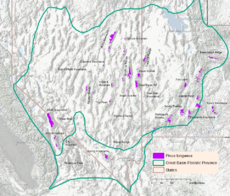Pinus longaeva facts for kids
Quick facts for kids Pinus longaeva |
|
|---|---|
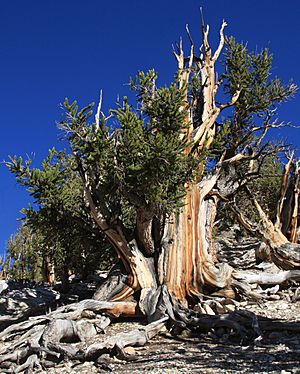 |
|
| A specimen in the Ancient Bristlecone Pine Forest, White Mountains, California | |
| Conservation status | |
| Scientific classification | |
| Genus: |
Pinus
|
| Species: |
longaeva
|
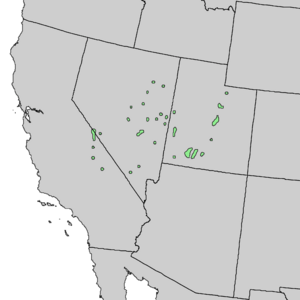 |
|
The Pinus longaeva, often called the Great Basin bristlecone pine, is a very old type of bristlecone pine tree. You can find these trees in the high mountains of California, Nevada, and Utah. One famous bristlecone pine, named Methuselah, is over 4,857 years old! It's known as the oldest living non-clonal (meaning it grew from a seed, not a copy of another plant) organism on Earth. To keep it safe, its exact spot is a secret. In 1987, the bristlecone pine became one of Nevada's state trees.
Contents
What Does the Bristlecone Pine Look Like?
This is a medium-sized tree. It usually grows to be about 5 to 15 meters (16 to 49 feet) tall. Its trunk can be very wide, up to 2.5 to 3.6 meters (8 to 12 feet) across.
The bark of the tree is a bright orange-yellow color. It is thin and flaky, especially near the bottom of the trunk.
Needles and Cones
The needles of the bristlecone pine grow in groups of five. They are strong and about 2.5 to 4 centimeters (1 to 1.5 inches) long. The needles are a deep green to blue-green color on the outside. On the inside, they have a bright white stripe where tiny pores, called stomata, are found. These pores help the tree breathe. Bristlecone pine needles stay green longer than almost any other plant's leaves. Some can stay on the tree for up to 45 years!
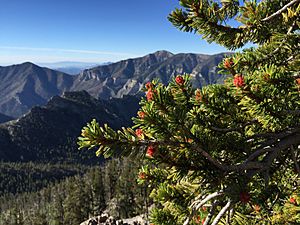
The cones are shaped like an oval cylinder. They are 5 to 10 centimeters (2 to 4 inches) long and 3 to 4 centimeters (1 to 1.5 inches) wide when closed. At first, they are green or purple. After about 16 months, they turn orange-buff. Each cone has many thin, delicate scales. Each scale has a bristle-like spine that is 2 to 5 millimeters (0.08 to 0.2 inches) long. This is where the name "bristlecone" comes from!
When the cones are ready, they open up to 4 to 6 centimeters (1.5 to 2.5 inches) wide. They release their seeds right away. The seeds are small, about 5 millimeters (0.2 inches) long, and have a wing that is 12 to 22 millimeters (0.5 to 0.9 inches) long. Most seeds are carried away by the wind. However, some are also spread by birds called Clark's nutcrackers.
Appearance of Old Trees
Older bristlecone pines often look twisted and stunted. This is especially true for trees growing in high places. Their bark is reddish-brown and has deep cracks. As the tree gets older, much of its living tissue, called the vascular cambium, can die. In very old trees, only a thin strip of living tissue might connect the roots to a few live branches.
The Great Basin bristlecone pine is different from other bristlecone pines. For example, its needles always have two clear resin canals. This means they don't have the small white resin spots seen on the needles of the Rocky Mountain bristlecone pine. Also, its cone bristles are longer than 2 millimeters, and its cones have a more rounded base than the foxtail pine. The green needles give the twisted branches a look like a bottle brush.
Where Do Bristlecone Pines Live?
You can find this tree species in Utah, Nevada, and eastern California. In California, they are mostly in the White Mountains, the Inyo Mountains, and the Panamint Range. In Nevada, they grow in most of the higher mountain ranges. In Utah, they are found northeast to South Tent in the Wasatch Range.
These trees usually grow in large, open groups. They don't form thick forests like some other pines. Bristlecone pine forests usually cover only 15-50% of the ground.
Bristlecone pines share their homes with other pine species. These include the ponderosa pine, the white fir, and the limber pine. The limber pine is another long-lived tree that grows in high places.
Growing Conditions
The bristlecone pine is a "vigorous" primary succession species. This means it grows quickly on new, open ground. However, it doesn't do well in rich soils where other plants can grow easily. So, it thrives best in tough places. Pinus longaeva is often the main tree species in high-elevation dolomite soils. These are rocky soils where not many other plants can survive.
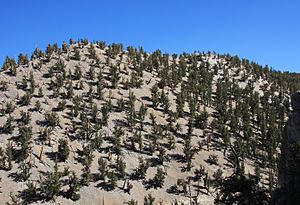
The United States government protects bristlecone pines in several areas. These include the Ancient Bristlecone Pine Forest in California and the Great Basin National Park in Nevada. In these areas, it is against the rules to cut or collect wood from the trees.
How Seeds Are Spread
Clark's nutcrackers are birds that pull P. longaeva seeds from the open cones. The nutcrackers eat some of these seeds. They also bury many seeds in the ground to save for later. Some of these buried seeds are never eaten and can grow into new trees. This helps the bristlecone pine spread.
Health of the Bristlecone Pine
There is a fungal disease called white pine blister rust that can affect some bristlecone pines. In 1998, the species was listed as "Vulnerable" on the IUCN Red List, meaning it was considered threatened. However, a survey in 2011 found that the number of Pinus longaeva trees was stable. The white pine blister rust was found to have very little effect on the overall population. Because of this, the species is now listed as "Least Concern," which means it is not currently threatened.
Bristlecone Pine and Fire
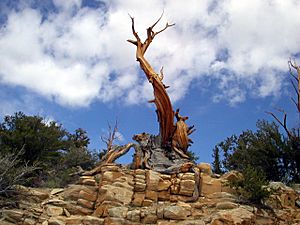
Bristlecone pines are very sensitive to fire. Even small fires can hurt them. Their bark has a lot of resin, which can catch fire quickly. A fire that reaches the top of the tree, called a crown fire, will almost certainly kill the tree.
However, bristlecone pine populations are very good at bouncing back after a fire. Since they are a primary succession species, they are expected to grow back quickly after a fire. Large fires are very rare where these trees grow. So, fires are not a big threat to the species in the long run.
Historically, bristlecone pine areas had fires that ranged from low to high intensity. The amount of fuel for fires changed a lot depending on how high up the mountain the trees were. At lower elevations, where different tree species mix, there is often a lot of fuel. These areas are also closer to where people might accidentally start fires. But at high elevations, near the treeline, bristlecone pines usually grow on rocky limestone areas. These areas have little to no fuel on the ground to spread a wildfire.
Warmer temperatures might make the fire season longer. This could mean more fires in bristlecone pine areas at low and middle elevations. These are the places where the trees are usually closer together and there is more fuel. While rare, big wildfires like the Carpenter 1 fire in Nevada (2013) and the Phillips Fire in Great Basin National Park (2000) could happen more often. These fires started at lower elevations and spread through the tops of the trees because of extreme fire weather.
How Old Are Bristlecone Pines?
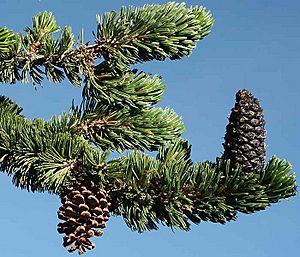
In 2010, a researcher named Tom Harlan found a bristlecone pine in the White Mountains of California that was measured to be 5,062 years old. This would make it the oldest known non-clonal tree in the world. To protect it, Harlan kept the exact location of this tree a secret. Sadly, Harlan passed away in 2013, and neither the tree nor the wood sample he studied have been found. So, we can't confirm its age or even if it still exists.
The oldest confirmed tree of this species is "Methuselah". It is also located in the Ancient Bristlecone Pine Forest in the White Mountains. Methuselah is 4,857 years old. Its age was found by counting the annual rings on a small wood sample taken with a special tool called an increment borer. Its exact location is also kept secret to protect it.
Among the trees in the White Mountains, the oldest ones are usually found on slopes that face north. These trees are, on average, 2,000 years old. Trees on south-facing slopes are, on average, 1,000 years old. The climate and the strong wood of these trees can preserve them long after they die. Some dead trees as old as 7,000 years can still be found next to living ones.
See also
 In Spanish: Pino longevo para niños
In Spanish: Pino longevo para niños



